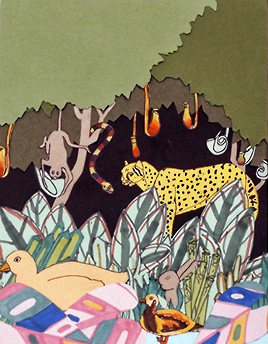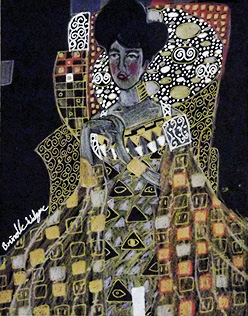Ten Dos and Don’ts for Planning Age Appropriate Art Activities

Star Worlds by Caroline G
I’ve never witnessed more confusion among parents concerning art education, than when their young artists reach grades 5 and 6. The reason for confusion is easy to understand. Suddenly, fifth-grader Bailey can glance at a picture of Queen Elsa and, with the deft swing of a pencil, recreate a second Queen Elsa. Sixth-grader Brandon, similarly, can bring Buzz Lightyear to life with only a few moments effort.
This ability to observe and copy images can lead families to believe that the next Michelangelo is on the horizon. Parents visit my studio with a sense of urgency, asking whether such a gifted child should begin formal art studies with the older students. I assure them that remaining in the elementary program is the correct way to go. In truth, it is quite common for earnest elementary students to develop the ability to mimic their favorite artwork, often Disney characters or anime. This ability reflects the child’s strong desire to emulate the adult artists they admire. It comes naturally to those who desire it and allows children to sponge in the art and culture from which their future artistic style will take root. This is an important phase in the evolution of many young artists. Unfortunately, without further guidance children can remain imitators, never advancing to create original art of their own.

Rousseau Dreamscape by Jason M.
Before deciding what types of art experiences would best serve youngsters in upper elementary, it helps to understand where these students are developmentally. Children at this age are first and foremost adventurers. After a good breakfast, their daily task is to explore the galaxy and map the universe. These explorers do not linger long in one spot but prefer to sample the place they are in today, while looking forward to the discoveries of tomorrow.
Young brains are crisscrossed by dozens of paths representing dozens of subjects. Learning is about sampling and exploring that network. Learning styles begin to evolve around ages 12/13 when brains start to specialize. Unexplored roads shrink into footpaths, while the roads most traveled expand into bustling freeways. By middle school students devote most of their time to the freeways, perfecting skills among subjects they’ve come to value, while rarely going down the old footpaths. This explains why a seventh grader will shade a graphite drawing for hours, while a fifth grader becomes restless after shading for only a few minutes, inquiring, “So what’s next?”
As a parent planning art activities, whether for home schooling or after-school enrichment, this understanding will guide you to activities that are fun, diverse and of short duration. When planning art activities think rocket ships and time machines. Guide your young artists on exciting journeys through space and time.
Listed Below are Dos and Don’ts for making upper elementary art activities relevant, age appropriate and fun:
-

Klimt Study by Brindle W.
DO offer a variety of art supplies. The goal is not to master watercolors but explore their potential. Likewise, pencils, markers, clay, and the junk that we throw in the trash are not a means to an end but possibilities for creative adventures.
- DO explore art history, touching on different cultures and eras through pictures, YouTube, books, museum trips and art projects. From the ancient rock paintings of the American Southwest to the Faberge Eggs of Russia, there are many exciting stories to tell.
- DO build art activities around the works of famous artists. Our favorites at CCS are Gustav Klimt, Claude Monet, Jan Pienkowski, Faith Ringgold, Henri Rousseau, and Charles Wysocki.
- DO supply a sketchbook. There are no rules about owning a sketchbook. Art is only limited by the student’s imagination.
- DO be a supportive audience and verbally appreciate insights, exploration, experimentation and problem solving.
- DON’T drill down on perfect execution at this age. For example, “Shade the apple until it looks like an apple,” is not age appropriate. For most students, the motor skills necessary to do this work are about two years in the future.
- DON’T set up a lengthy project of several weeks’ duration. Our lessons run from one to three classes.
- DON’T assume there is only one correct way to execute a project if the student has another vision.
- DON’T expect a student to master an art material at this age. Students need to become comfortable first, and feel free to experiment second. Mastery is in the future.
- DON’T make an issue about mistakes. Rather downplay mistakes. At CCS we call mistakes “happy accidents” since some of our most creative ideas have grown out of happy accidents.
Of course, don’t forget to join in the fun. Mapping the art world across time and space in the lower grades will serve as a critical foundation for the evolution of the young artist’s personal style in adolescence.


